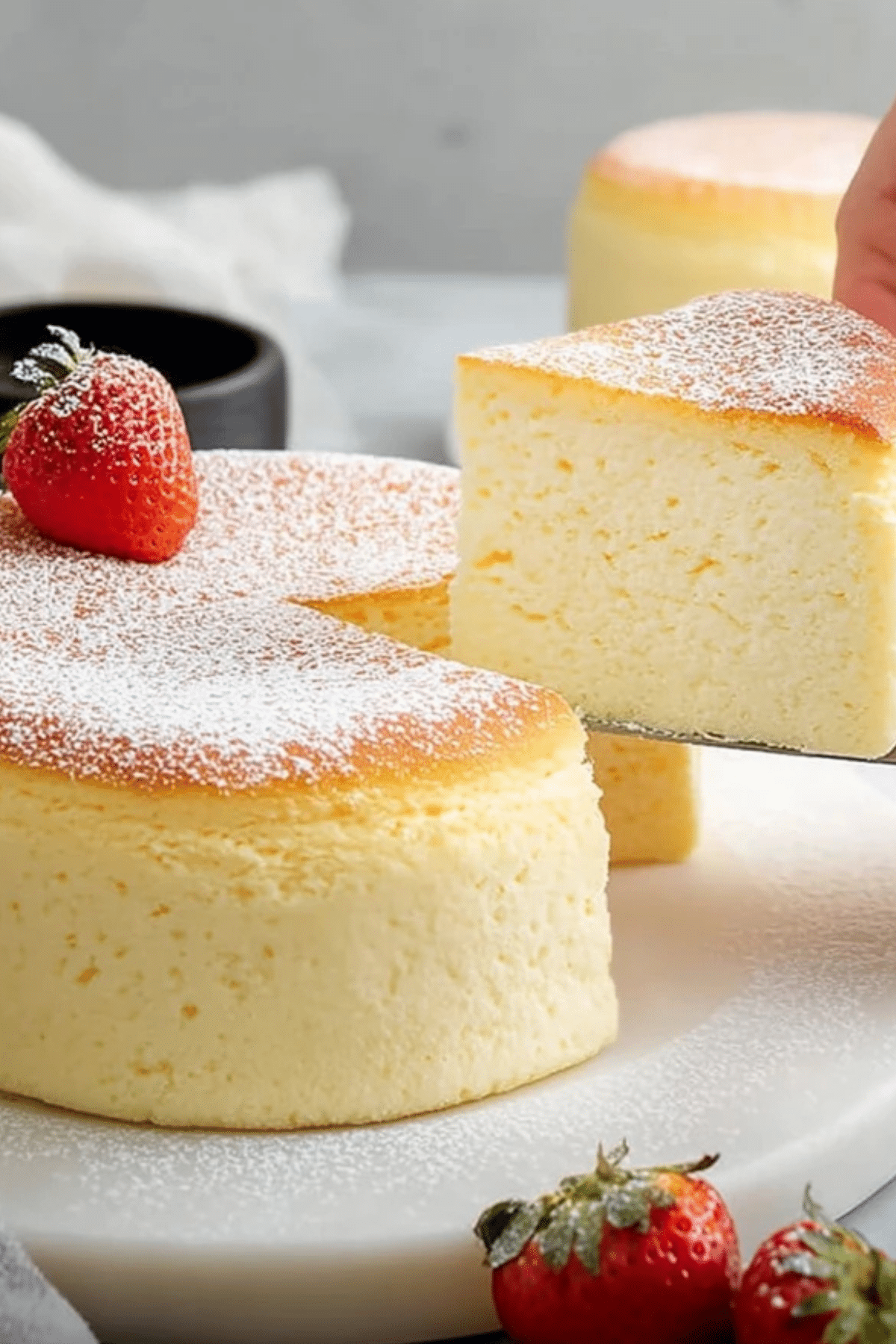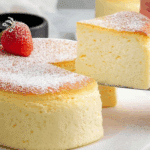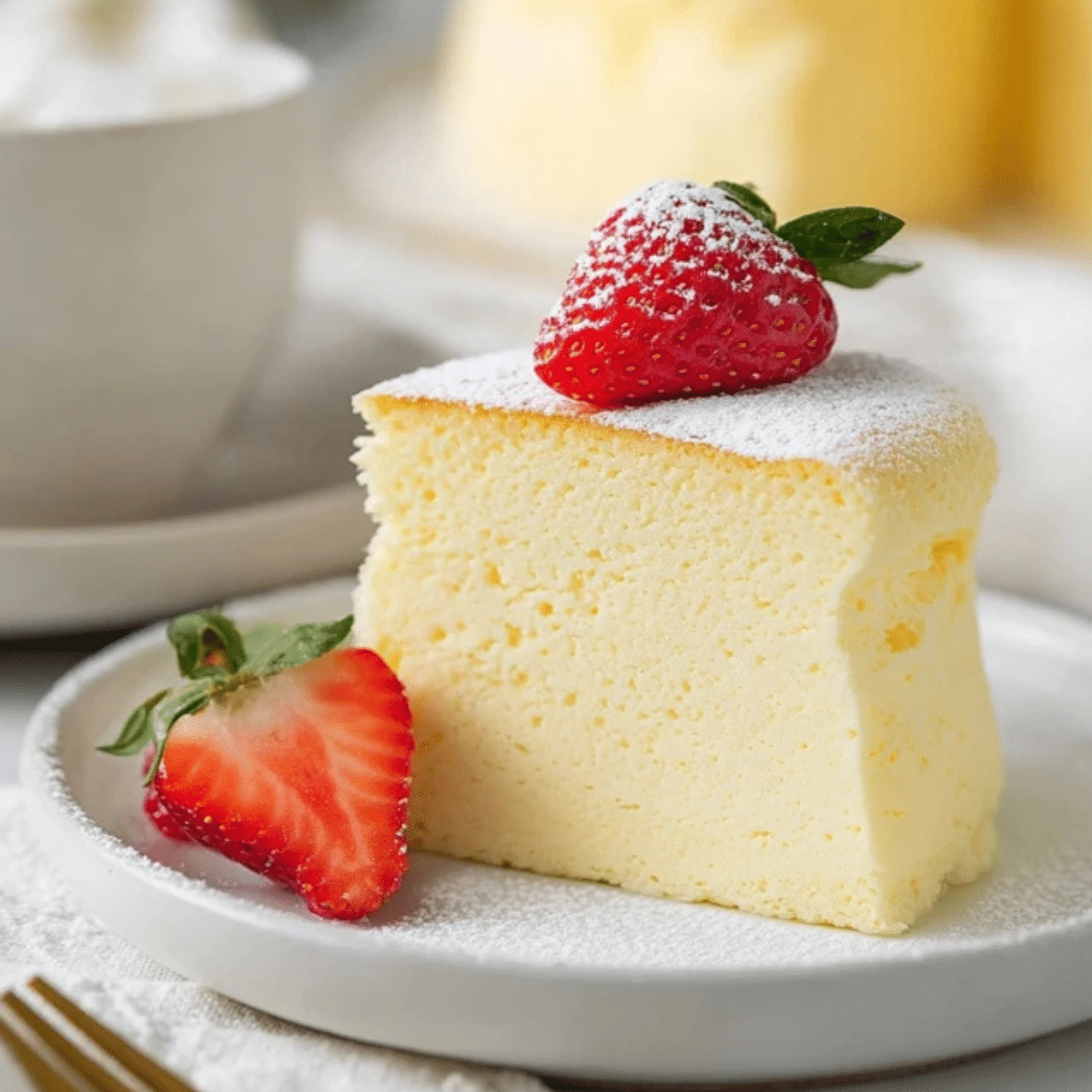Japanese Cotton Cheesecake, also known as Japanese Souffle Cheesecake, is a unique dessert that has gained popularity for its airy, light texture and delicate, melt-in-your-mouth quality. Unlike the traditional dense and creamy American cheesecake, this version boasts a soft, spongy texture that combines the best qualities of both a cheesecake and a soufflé. If you’re a fan of light, fluffy desserts with a subtle sweetness, this cake is sure to impress!
Table of Contents
What Makes Japanese Cotton Cheesecake Special?
Japanese Cotton Cheesecake is beloved for its cloud-like texture that’s both soft and bouncy. The use of whipped egg whites creates a delicate meringue that, when folded into the batter, provides the airy lift that makes this cheesecake stand out. Unlike traditional cheesecakes that often rely on a buttery crust, this recipe skips the crust entirely, focusing on the cheesecake’s rich, smooth interior. The result is a cake that feels incredibly light while still delivering the signature tangy cheesecake flavor.
Ingredients for Japanese Cotton Cheesecake
Here are the essential ingredients you’ll need to make this dreamy dessert:
• Cake Flour: This soft flour ensures a light, airy texture. If you don’t have cake flour, you can substitute it with a mixture of all-purpose flour and cornstarch.
• Cornstarch: A key ingredient for creating the light, jiggly texture that Japanese Cotton Cheesecake is famous for.
• Cream Cheese: Full-fat cream cheese provides a rich, tangy flavor essential to the cheesecake. Ensure it’s at room temperature for easy mixing.
• Butter: Adds moisture and richness to the cake. Use unsalted butter to control the level of salt.
• Whole Milk: Full-fat milk is used to maintain moisture and create a creamy consistency.
• Eggs: Both the egg yolks and whites are used, with the whites whipped into a meringue that gives the cake its signature fluffiness.
• Granulated Sugar: Helps stabilize the meringue, allowing it to form soft peaks.
• Vanilla Extract: Adds a subtle flavor that complements the richness of the cream cheese.
• Lemon Juice: A touch of acidity that helps stabilize the meringue and adds a fresh flavor.
Alternative Ingredient Suggestions
For a dairy-free version, you can substitute the cream cheese with a dairy-free cream cheese alternative. You can also use almond milk or oat milk instead of whole milk for a lighter, non-dairy option. If you’re avoiding gluten, consider replacing the cake flour with a gluten-free flour blend. However, be mindful of the texture changes when making these substitutions.
Step-by-Step Instructions for Making Japanese Cotton Cheesecake
- Prepare the Pan: Preheat your oven to 300°F (150°C) and line a 6-inch round baking pan with parchment paper on both the bottom and sides.
- Melt the Butter and Cream Cheese: Over a double boiler, melt the butter and cream cheese together with the milk. Whisk until the mixture is smooth and reaches about 130°F (55°C).
- Mix in the Egg Yolks and Vanilla: Remove the mixture from the heat, then whisk in the egg yolks and vanilla extract until fully incorporated.
- Sift in Cake Flour and Cornstarch: Sift the cake flour and cornstarch into the batter to prevent lumps. Whisk until smooth.
- Make the Meringue: In a separate bowl, beat the egg whites with lemon juice until frothy. Gradually add sugar in three parts, continuing to beat until medium-soft peaks form.
- Combine the Mixtures: Carefully fold a third of the meringue into the batter to lighten it, then gently fold the rest of the meringue into the batter, being careful not to deflate it.
- Prepare for Baking: Pour the batter into the prepared pan, filling it halfway. Tap the pan to release large air bubbles. Place the pan in a larger baking dish and add about 1-2 cm of hot water to create a water bath.
- Bake the Cheesecake: Bake at 300°F (150°C) for 30 minutes, then reduce the temperature to 230°F (110°C) for another 30 minutes. Finally, increase the temperature to 275°F (135°C) and bake for 13-15 minutes. The top should be golden, and a toothpick inserted should come out mostly clean.
- Cool the Cake: Turn off the oven and leave the cheesecake in the oven with the door slightly ajar for 15 minutes. Remove the cheesecake from the water bath and let it cool in the oven for another 15 minutes before transferring to a cooling rack.
- Serve and Enjoy: Dust the cooled cheesecake with powdered sugar and enjoy the jiggly, fluffy delight!

Tips & Tricks for the Perfect Japanese Cotton Cheesecake
- Whip the Egg Whites Properly: It’s crucial to whip the egg whites to medium-soft peaks to achieve the right texture. Over or under whipping can affect the final fluffiness of the cake.
- Use a Water Bath: Baking the cheesecake in a water bath helps to regulate the temperature and prevents the cheesecake from cracking. Ensure the water level is sufficient to maintain moisture in the oven.
- Be Patient with the Temperature: Don’t rush the baking process. Bake the cheesecake slowly at low temperatures to ensure it rises evenly without cracking.
- Cool Gradually: After baking, let the cheesecake cool slowly to prevent it from shrinking due to a sudden temperature change.
Pairing Ideas and Variations
Japanese Cotton Cheesecake is delightful on its own, but you can elevate the experience with a variety of pairings. Serve it with fresh berries or a drizzle of matcha syrup for an extra layer of flavor. For a fun twist, consider adding a fruit compote or a scoop of vanilla ice cream on the side.
If you’re looking to make the cheesecake gluten-free, simply swap out the cake flour for a gluten-free flour blend. You can also try a chocolate variation by incorporating cocoa powder into the batter for a chocolate Japanese Cotton Cheesecake.
Storing and Serving Suggestions
While this cake is best served fresh, it can be stored in an airtight container in the refrigerator for up to five days. As with most delicate cakes, the texture may change slightly after refrigeration, but it will still be delicious. To enjoy it at its best, serve it chilled or at room temperature.
Japanese Cotton Cheesecake is a showstopper at any gathering, and with the right techniques, you can create this delicate, melt-in-your-mouth dessert at home. The combination of its light texture and rich flavor makes it a favorite for any occasion.
Conclusion
Japanese Cotton Cheesecake is the perfect dessert for anyone looking to indulge in a light and fluffy treat that’s both satisfying and incredibly delightful. With its airy texture and rich, creamy flavor, it’s no surprise that this dessert has become a favorite among cheesecake lovers worldwide. While the baking process may require a bit of patience and attention to detail, the end result is worth every effort. Whether you’re making it for a special occasion or simply craving a delicious homemade dessert, Japanese Cotton Cheesecake will leave everyone impressed and coming back for more.
Frequently Asked Questions (FAQ)
1. Why is my Japanese Cotton Cheesecake not fluffy?
A common reason for a flat cheesecake is underwhipping the egg whites. To achieve the perfect fluffy texture, ensure you whip the egg whites until they form medium-soft peaks. If overmixed or undermixed, the meringue may deflate, resulting in a denser cake. Also, remember not to over-mix the batter when combining the meringue with the rest of the ingredients, as this can also cause a loss of fluffiness.
2. Can I use a different type of cheese for this recipe?
While cream cheese is the traditional choice, you can experiment with other varieties such as mascarpone or ricotta cheese. However, keep in mind that these substitutes might slightly alter the flavor and texture. Full-fat cream cheese is recommended for the best results, as it helps provide that signature rich and tangy cheesecake flavor.
3. How can I prevent cracks in my Japanese Cotton Cheesecake?
To prevent cracks, make sure to bake your cheesecake slowly in a water bath. The hot water bath regulates the oven temperature, keeping the cheesecake moist and helping it rise evenly. Also, avoid opening the oven door frequently to check on the cake, as sudden temperature changes can cause it to crack.
4. Can I make this cheesecake in advance?
Yes! Japanese Cotton Cheesecake is a great make-ahead dessert. You can store it in an airtight container in the refrigerator for up to 5 days. However, note that the texture may change slightly as it chills. To enjoy it at its best, serve it chilled or at room temperature before serving
More Relevant Recipes
- Apple Cider Cheesecake – Perfect Fall Dessert: This cheesecake combines the flavors of tangy apple cider with creamy cheesecake for a perfect fall-inspired treat. Much like Japanese Cotton Cheesecake, it features a smooth, velvety texture and is ideal for special occasions or cozy fall gatherings.
- Turtle Cheesecake Recipe: Indulge in a rich, decadent dessert with this Turtle Cheesecake, which features a chocolate, caramel, and pecan topping over a creamy cheesecake base. Similar to the airy texture of Japanese Cotton Cheesecake, this variation offers a rich flavor that is perfect for those who love classic cheesecake with a twist.
- Cinnamon Roll Cheesecake Recipe: A delightful fusion of cinnamon rolls and cheesecake, this recipe combines the warm, comforting flavors of cinnamon with the creamy texture of cheesecake. It’s a great choice for those who love sweet, spiced desserts with a cheesecake base, similar to the Japanese Cotton Cheesecake’s soft, delicate texture.

Japanese Cotton Cheesecake
- Total Time: 1 hour 35 minutes
- Yield: 5 servings
- Diet: Vegetarian
Description
Japanese Cotton Cheesecake is a light, fluffy, and melt-in-your-mouth dessert with a rich, creamy cheesecake flavor and a soft, bouncy texture. Unlike traditional cheesecakes, it doesn’t require a crust and relies on whipped egg whites for its airy structure. Perfect for special occasions or a sweet treat, this dessert is both indulgent and delicate.
Ingredients
- ¼ cup (30 g) cake flour
- 2 tablespoons (20 g) cornstarch
- ¾ cup (180 g) cream cheese, full-fat brick
- 2 tablespoons (30 g) unsalted butter, room temperature
- 3½ tablespoons (50 g) whole milk
- 3 large egg yolks, room temperature
- ½ teaspoon (2 g) vanilla extract
- 3 large egg whites, room temperature
- ⅓ cup (70 g) granulated sugar
- ½ teaspoon (2 g) lemon juice
- Powdered sugar (for garnish)
Instructions
- Preheat your oven to 300°F (150°C) and line a 6-inch round baking pan with parchment paper.
- Over a double boiler, melt the butter and cream cheese together with the milk. Whisk until smooth and reach about 130°F (55°C).
- Remove from heat and whisk in the egg yolks and vanilla extract.
- Sift in the cake flour and cornstarch. Whisk until smooth and strain the batter through a fine-mesh sieve.
- In a separate bowl, beat the egg whites and lemon juice until frothy. Gradually add the sugar in 3 parts while beating until medium-soft peaks form.
- Fold a third of the meringue into the batter to lighten it, then gently fold in the remaining meringue until combined.
- Pour the batter into the prepared pan and tap it to release large air bubbles. Place the pan in a larger baking dish and add 1-2 cm of hot water for a water bath.
- Bake at 300°F (150°C) for 30 minutes, then reduce the temperature to 230°F (110°C) and bake for another 30 minutes. Increase the temperature to 275°F (135°C) and bake for 13-15 minutes until golden and a toothpick comes out mostly clean.
- Turn off the oven and leave the cheesecake in with the door cracked open for 15 minutes. Then remove it from the water bath and let it cool in the oven for another 15 minutes.
- Remove from the pan, cool completely, and dust with powdered sugar before serving.
Notes
- Ensure the egg whites are whipped to medium-soft peaks for the best texture.
- Bake the cheesecake slowly in a water bath to prevent cracking and dryness.
- Don’t open the oven door frequently while baking to maintain even heat.
- Let the cheesecake cool gradually in the oven to avoid shrinkage.
- This cheesecake is best enjoyed within 5 days of making and can be stored in the fridge.
- Prep Time: 20 minutes
- Cook Time: 1 hour 15 minutes
- Category: Dessert
- Method: Baked
- Cuisine: Japanese
Nutrition
- Serving Size: 1 slice
- Calories: 224 kcal
- Sugar: 17 g
- Sodium: 324 mg
- Fat: 8 g
- Saturated Fat: 4 g
- Unsaturated Fat: 3 g
- Trans Fat: 1 g
- Carbohydrates: 25 g
- Fiber: 1 g
- Protein: 12 g
- Cholesterol: 116 mg

